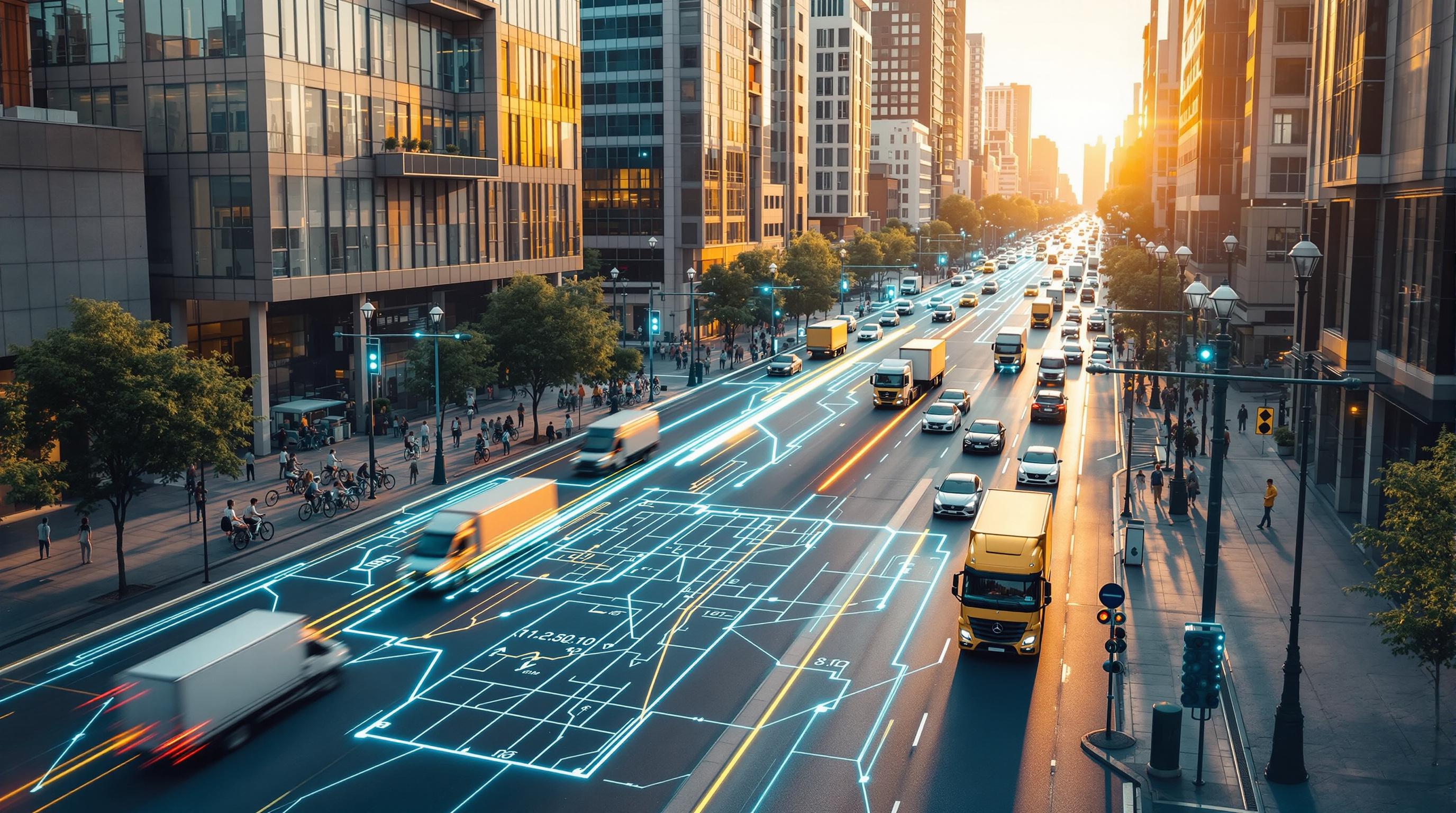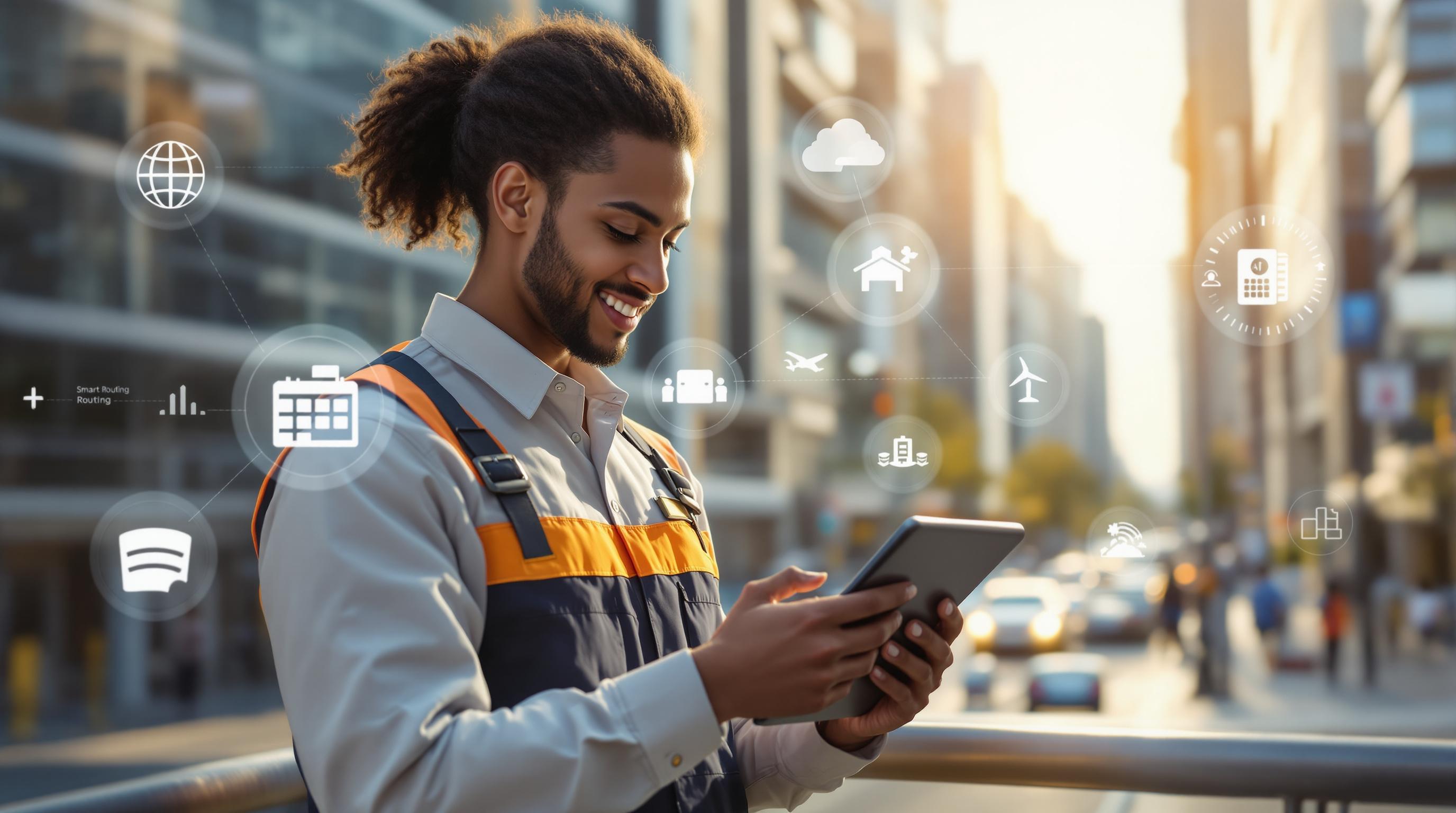AI is transforming urgent deliveries by optimizing routes in real-time to save time and reduce costs. It uses live traffic data, GPS signals, weather updates, and incident reports to adjust routes instantly, ensuring deliveries stay on schedule. Here's how it works:
- Real-Time Traffic Analysis: AI evaluates live traffic conditions and predicts delays.
- Dynamic Route Updates: Routes are adjusted instantly based on current conditions.
- Fuel and Time Savings: Reduces idling, fuel consumption, and delivery times.
- Handling Unexpected Events: Reroutes around accidents, closures, or severe weather.
- Improved Customer Experience: Provides accurate delivery times and proactive updates.
AI-powered systems like Routemize are making urgent deliveries faster, more efficient, and reliable, especially in busy urban areas. Keep reading to learn how this technology works and why it's a game-changer for logistics.
Optimizing Last Mile Delivery Efficiency with AI Powered ...
AI Traffic Data Analysis Methods
Modern AI systems improve urgent deliveries by constantly analyzing live traffic and related signals. This process relies on a variety of real-time data sources, explained below.
Traffic Data Sources
AI-powered route optimization depends on data streams like traffic cameras, GPS signals, weather updates, and incident reports. For example, Routemize's AI uses these inputs to adjust delivery routes in real time, ensuring quick and efficient route changes when needed.
U.S. Data Standards
To optimize routes effectively, systems must follow U.S. standards. These include using miles for distance, mph for speed, and Fahrenheit for temperature. Such standardization ensures accurate navigation through different traffic scenarios, helping to meet tight delivery timelines.
Live Route Updates for Urgent Deliveries
Using advanced AI-driven data analysis, live updates keep deliveries on schedule by constantly monitoring real-time data to make smart routing decisions.
How Route Updates Work
When traffic patterns shift, the AI system follows a clear process to ensure deliveries stay efficient:
1. Initial Assessment
The system evaluates the current route using live traffic data, analyzing factors like speed, congestion, and estimated arrival times.
2. Generating New Routes
Based on updated traffic information, the AI creates several alternative routes, carefully weighing travel time and reliability for each.
3. Instant Implementation
Once the best route is identified, it’s sent directly to drivers' navigation systems. Routemize's AI ensures smooth transitions between routes without disrupting the delivery sequence.
Saving Time and Fuel
This process delivers real benefits by cutting delays and lowering fuel consumption.
In busy urban environments, real-time routing is especially impactful. By steering vehicles away from heavy traffic during peak hours, the system achieves:
- Reduced idling and stop-and-go driving, which lowers fuel usage
- More accurate delivery windows
- Shorter overall delivery times
If traffic worsens, the AI quickly decides whether a route change is necessary, ensuring every adjustment adds value rather than causing unnecessary detours.
For urgent deliveries, these updates are critical. The system prioritizes time-sensitive shipments, giving them the best possible routes to meet tight deadlines. This proactive method ensures critical deliveries stay on track.
sbb-itb-7020db0
Handling Unexpected Road Events
When unexpected incidents occur on the road, delivery schedules can be at risk. AI systems step in to detect these issues and quickly reroute deliveries to keep things on track.
Spotting Problems Early
AI systems monitor real-time data to identify potential traffic disruptions. Here's how they gather information:
- Traffic sensors pick up sudden speed drops or halted vehicles.
- Emergency service updates signal accidents or road closures.
- Weather radar data highlights severe weather conditions.
- Municipal alerts notify of construction or special events.
These systems process data in seconds, enabling a fast response to new problems. For example, Routemize's AI technology can quickly spot traffic changes, alert drivers, and suggest route adjustments. This ensures drivers stay informed and can adapt as needed.
Fast Route Adjustments
When disruptions are detected, the AI follows a structured process to minimize delays:
-
Assessing the Situation
It evaluates the severity and expected duration of the issue to understand its impact. -
Creating Alternative Routes
Using live traffic data, delivery schedules, vehicle specifics, and road restrictions, the AI generates new route options. -
Implementing the Best Route
The updated route is sent directly to drivers' navigation systems, providing clear guidance for the adjusted plan.
This streamlined approach helps maintain delivery efficiency, even in the face of unexpected challenges.
AI Route Planning Results
Time and Cost Impact
Using AI for route optimization, as seen with Routemize, helps reduce driving time and fuel usage while increasing the number of deliveries completed per shift. By analyzing traffic in real-time, it avoids delays that could lead to missed delivery windows or penalties. For example, one major U.S. fleet reported saving a considerable amount on fuel and labor costs each month thanks to AI-driven planning.
Customer Results
AI route planning enhances customer satisfaction by providing accurate, up-to-date arrival times. If a delay is expected, the system automatically informs customers with revised delivery times, ensuring clear communication and building trust. This level of reliability is particularly crucial for industries like medical supply delivery, perishable food transport, and express courier services, where timing is critical.
Manual vs. AI Route Planning
The contrast between manual and AI-based route planning becomes especially apparent when managing multiple urgent deliveries in congested areas. Here's a comparison:
| Factor | Manual Route Planning | AI Route Planning |
|---|---|---|
| Response Time | Slow recalculation of routes | Instant route generation |
| Accuracy | Less efficient routes | Optimized and precise routes |
| Cost Efficiency | Higher operational expenses | Lower costs through better planning |
| Traffic Prediction | Limited to current conditions | Predictive analysis of patterns |
| Route Updates | Rarely adjusted | Continuously updated in real-time |
| Multi-Stop Planning | Limited capacity | Effective multi-stop optimization |
These differences highlight how AI-powered systems improve efficiency and reliability, especially for urgent and time-critical deliveries.
Conclusion
AI-powered route planning is changing the game for urgent delivery logistics in U.S. cities. By turning complex traffic patterns into manageable, efficient routes, this technology helps delivery operations consistently meet tight deadlines.
With real-time adjustments, systems like Routemize keep schedules on track while cutting costs - critical for navigating the unpredictable traffic in metropolitan areas. This is especially helpful when coordinating multiple urgent deliveries in busy urban settings.
The future of delivery logistics lies in AI systems that can process massive amounts of traffic data in an instant. This not only boosts operational efficiency but also improves delivery accuracy, leading to higher customer satisfaction. These advancements are helping businesses move away from manual planning toward smarter, automated solutions.
The adoption of AI in route planning is already making a noticeable difference in daily logistics. By using predictive traffic analysis, companies can offer more reliable urgent deliveries and gain a competitive edge in today’s fast-paced market.
FAQs
How does AI help ensure on-time deliveries during unexpected traffic or severe weather?
AI leverages real-time data to analyze traffic patterns, road conditions, and weather updates, allowing it to dynamically adjust delivery routes. This ensures that time-sensitive deliveries can avoid unexpected delays caused by congestion or adverse weather.
By continuously adapting routes based on current conditions, AI helps minimize travel time and keep deliveries on schedule, even during unpredictable events. This smart optimization not only improves efficiency but also enhances reliability for businesses and customers.
What real-time data does AI use to optimize delivery routes, and how accurate is it?
AI relies on a variety of real-time data sources to optimize delivery routes, ensuring timely and efficient deliveries. These sources typically include live traffic updates, GPS location data, weather conditions, and even historical traffic patterns. By analyzing these inputs, AI can dynamically adjust routes to avoid delays caused by congestion, accidents, or road closures.
The reliability of this data is generally very high, as it is sourced from trusted systems like traffic monitoring networks, satellite data, and connected vehicle sensors. However, the accuracy can occasionally vary depending on factors like data refresh rates or unexpected events, but advanced AI systems are designed to adapt quickly to new information to maintain optimal routing.
How does AI-driven route planning improve delivery efficiency and customer satisfaction?
AI-driven route planning enhances delivery efficiency by analyzing real-time traffic data and optimizing routes to avoid delays. This ensures that urgent deliveries arrive on time, meeting customer expectations and reducing frustration.
By adapting routes dynamically based on traffic and appointment locations, AI helps businesses save valuable time. This not only improves delivery speed but also allows for more personalized and reliable service, boosting overall customer satisfaction.


